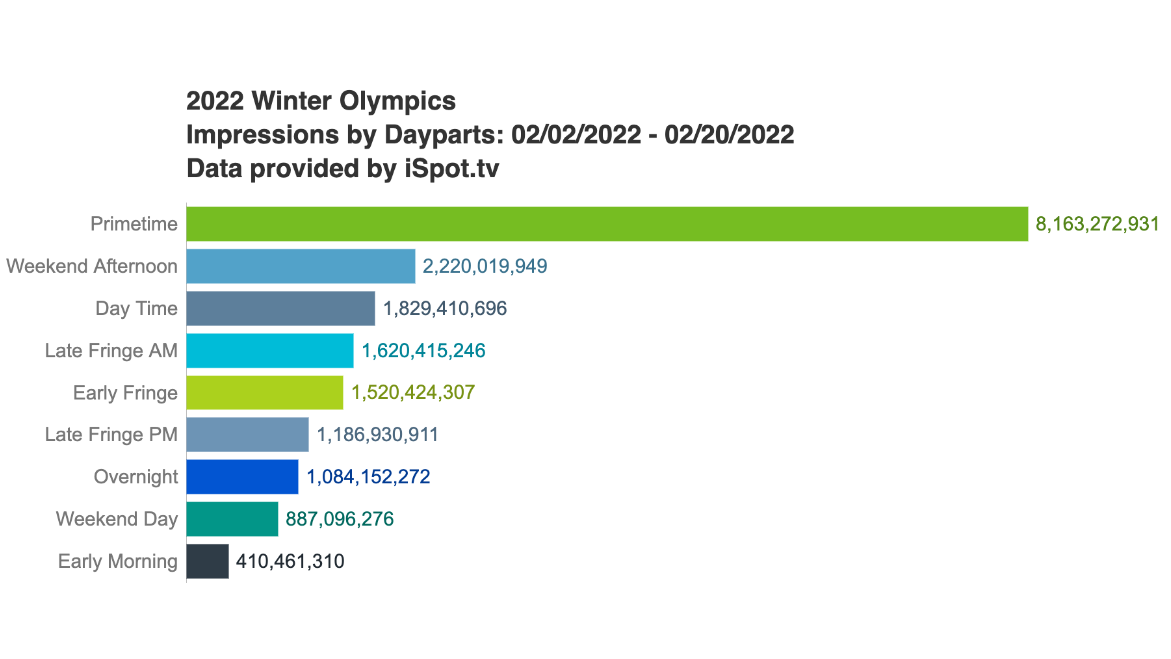163 Million People Watched Olympics: iSpot.TV
Games reached 27.4 million via streaming

The Winter Olympics from Beijing reached 163 million people across linear and streaming television, according to iSpot.TV, a measurement firm that worked with NBCUniversal.
Viewers watched 41.8 billion minutes of Olympic programming across platforms.
There were 27,4 million streaming viewers, with 66%, or 18 million viewers watching exclusively on NBCU’s Peacock or other streaming services, iSpot said. Another 9.3 million viewers watched the Olympics via both traditional TV and streaming.
While traditional ratings were down, linear TV reached 75.1 million unique households, or about 61.6% of all U.S. households. Another 12.8 million households streamed Olympic programming.
iSpot said the most viewed moment during the games was when Kallie Humphries won the gold medal for monobob. That came directly after the end of Super Bowl LVI, which was also broadcast and streamed by NBC and measured by iSpot.
iSpot.TV is one of the newer measurement firms using big data to offer alternative to Nielsen, which has dominated TV measurement for decades.
Also: Analysis: Super Bowl Could Kick Off Media Measurement Multiverse Mess
NEXT TV NEWSLETTER
The smarter way to stay on top of the streaming and OTT industry. Sign up below.
One of iSpot’s specialties is measuring advertising on a second-by-second basis.. iSpot said that the Olympics averaged more than 1 billion ads delivered per day, generating 19.95 billion TV ad impressions in 18 days.
"Instead of using program ratings as a proxy for advertising intelligence, iSpot verified close to 20 billion impressions and enabled the market to contextualize that massive reach against a variety of factors, such as day part, competitive set, et cetera,” said iSpot CEO Sean Muller.
During primetime, Olympic programming had a 22% lower ad loads compared to programming on the other Big 4 broadcast networks, and delivered 262% more impressions per spot than the other three networks combined.
Commercials on the Olympics had a 98% completion rate, meaning that nearly everyone who saw an Olympic ad watched all of it. Completion rates are usually associated with digital advertising, where the average completion rate is about 50%.
Naturally, the advertising on the Olympics was tops in terms of share of voice at 12.3%, which was 307% higher than the No. 2 program. In primetime, Olympic commercials had a 30% share of voice among the broadcast networks.
Commercials for companies in 83 industries ran 603 unique ads during the Olympics. The 16,199 ad airing generated 7,383 minutes of ad time, including 1,678.5 in primetime.
Advertising in the Olympics had 12% higher engagement rates that the industry average during the games.
“The Olympics will go down as a watershed moment between the buyers and sellers of TV in that we finally had a new set of facts and language to assess the value exchange,” said Muller. “By lunch time the next day, both sides could verify the (significant) reach from streaming, analyze the overlap and see how the games got them into the homes of cord cutters.” ■
Jon has been business editor of Broadcasting+Cable since 2010. He focuses on revenue-generating activities, including advertising and distribution, as well as executive intrigue and merger and acquisition activity. Just about any story is fair game, if a dollar sign can make its way into the article. Before B+C, Jon covered the industry for TVWeek, Cable World, Electronic Media, Advertising Age and The New York Post. A native New Yorker, Jon is hiding in plain sight in the suburbs of Chicago.

